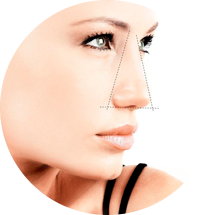Face
Facial plastic surgery is one of the most popular areas in aesthetic surgery.
Such operations are used both for aesthetic purposes (to correct age-related changes in the face) and reconstructive – to eliminate and correct congenital or post-traumatic deformities.
FACE LIFT – Facelift
Facelift (Facelift, Facelift, SMAS-lifting or SMAS-facelift) is an operation aimed at eliminating age-related changes in the middle and lower third of the face (all parts below eye level – cheeks, cheekbones, nasolabial folds, neck), by pulling up and return to the original place of the descended soft tissues of the face. The musculo-aponeurotic system (SMAS) and the skin covering it are tightened and fixed.
Historical and contemporary views.
An often heard name is the circular lift. Outdated, incorrect, misleading name. Initially, such an operation looked like this: / LINK, Gonzalez-Ulloa, 1970 /. Slits all around the head except for the occiput. A modern facelift has little to do with that surgery. It’s like calling a Mercedes a 4-wheeled cart.
A skin-only facelift was used in the 70s of the 20th century and with the advent of the SMAS component is not used now and is only of historical interest.
Therefore, if we are talking about FACELIFT, we mean a facelift ONLY using SMAS in its various, numerous modifications. That is: if we say that “we flew on vacation”, it is clear to everyone that in 99% of cases we flew by plane. This does not need to be specified. The situation is the same with SMAS. Without this stage, the surgery is impossible.
The same situation is with individual “descriptions” on Instagram of lifting “cheeks”, “cheekbones”, “neck”, “paint bags” and so on and so forth. The lifting of these departments is a COMPONENT AND MANDATORY part of a facelift. Again, listing the neck, cheeks and cheekbones separately is just as unnecessary as specifying that you cooked borsch with cabbage and beets. This is implied. Whereas a separate listing is only misleading.
Isolated neck plastic surgery is advisable and used quite rarely, since almost always, if there are changes in the neck, they are also some changes in other areas. That is, a tightened neck after the surgery looks unnatural against the background of drooping cheeks. The aesthetic outcome of an isolated neck lift usually does not meet the patient’s expectations. The situation is the same with the middle zone of the face. A separate cheek lift is done at the age of 30-40 and is quite rare. As a rule, such an operation is performed endoscopic and in combination with a lifting of the upper third / forehead-eyebrows /, up to 40 years. Later, as a rule, it is no longer advisable, because there are changes in the neck and elsewhere. That is, you need to do a facelift, and not separately tighten the cheeks, cheekbones, neck, jaw area, etc.
Therefore, plastic surgeons prefer to carry out a standard face-lifting, as this allows you to correct two anatomical zones of the face at once: the middle (from the eyes to the jaw) and the lower (neck). In combination, this gives excellent results – the effect of rejuvenation is subjectively estimated at 10-15 years.
This operation is often combined with endoscopic forehead lift and blepharoplasty.




